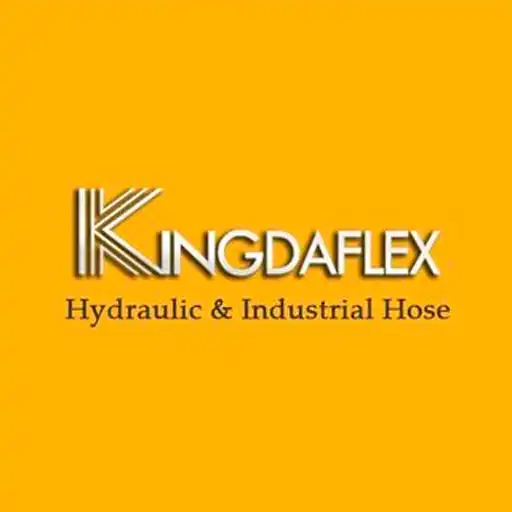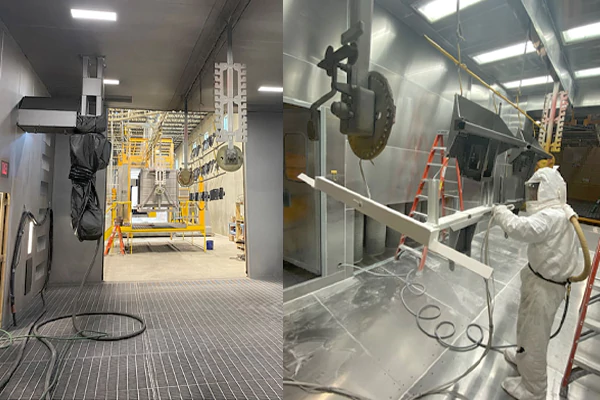AN and JIC fittings may look nearly identical, but they serve different industries and have distinct performance standards. Understanding their differences is essential for choosing the right component.
This blog breaks down the key distinctions between AN (Army-Navy) and JIC (Joint Industry Council) fittings, helping you avoid mismatches and ensure safe, reliable connections in hydraulic and fuel systems.
What are AN Fittings?
AN fittings—short for Army-Navy—are high-performance fluid connectors originally developed for military and aerospace applications. They feature a 37-degree flare design, which provides a secure, leak-free seal in high-pressure environments.
Key Features of AN Fittings:
- Thread Type: Uses UNF (Unified National Fine) threads
- Flare Angle: 37-degree flare for sealing
- Materials: Typically made from aluminum or stainless steel
- Sizes: Identified by a dash number (e.g., -6 AN = 6/16” or 3/8”)
AN fittings are widely used in performance automotive, racing, and aviation due to their reliability and easy installation.
What Are JIC Fittings?
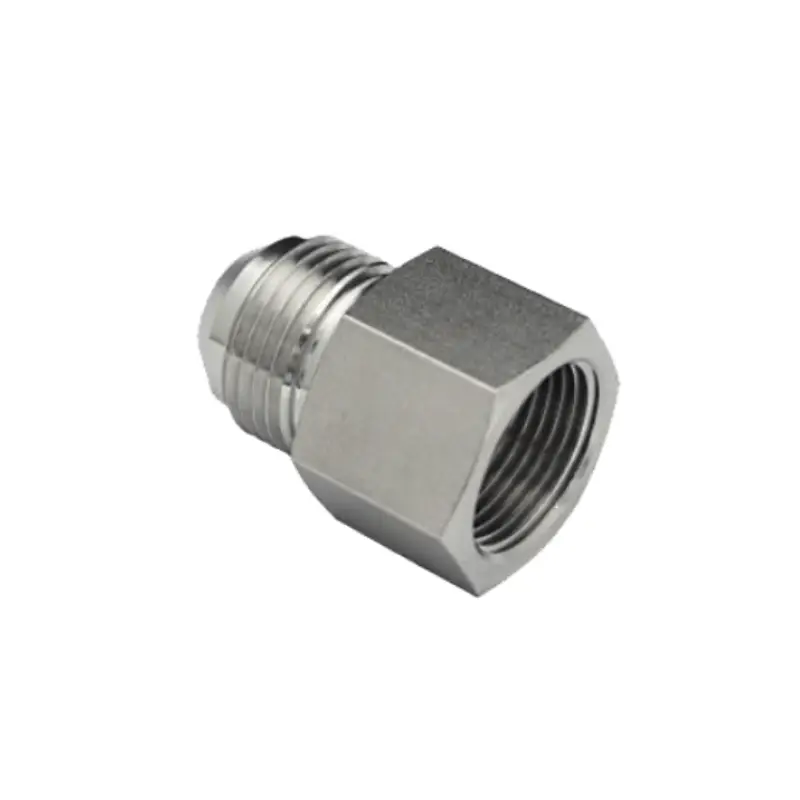

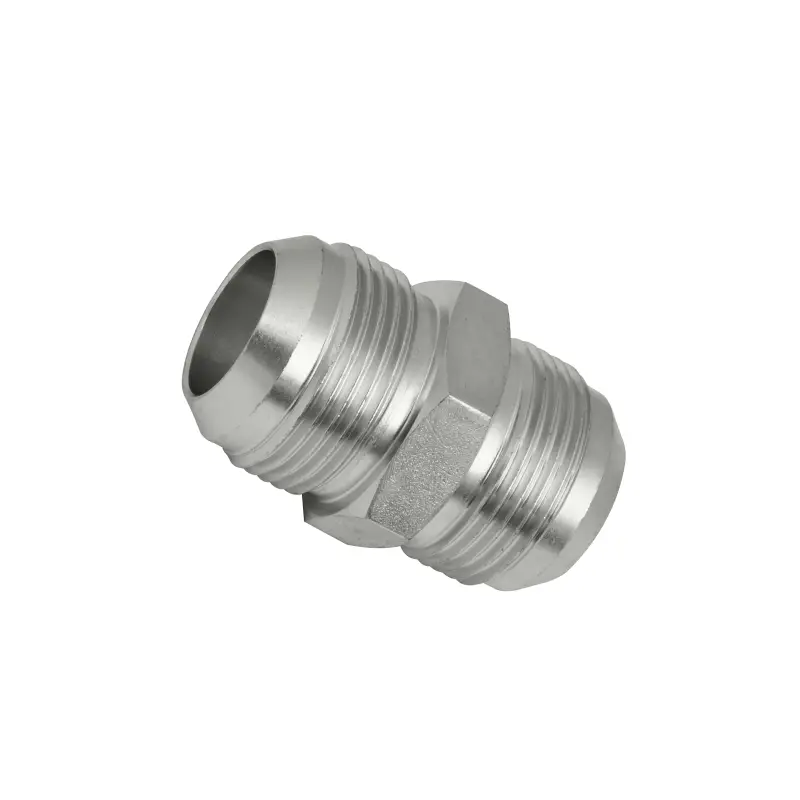
JIC (Joint Industry Council) fittings are standardized hydraulic fittings that use a 37-degree flare seating surface to create a metal-to-metal seal. Made to SAE J514 standards, they are widely used in high-pressure fluid systems, especially in industries like agriculture, construction, and automotive.
Key Features of JIC Fittings:
- 37° Flare Design: Ensures a tight, leak-free seal.
- Thread Type: Straight threads (UNF/UN) with a mechanical seal.
- Material Options: Usually available in carbon steel, stainless steel, or brass.
- Reusability: Can be disconnected and reconnected multiple times without compromising performance.
JIC fittings are valued for their durability, versatility, and ease of use, making them a go-to choice for many hydraulic applications.
AN vs JIC Fittings
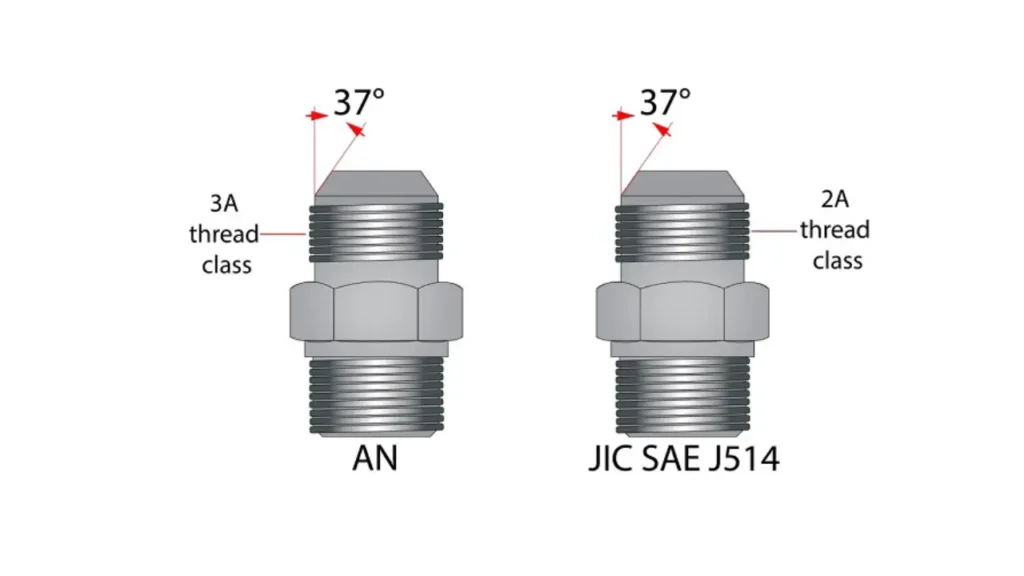
When working with fluid transfer systems, selecting the correct fittings is crucial for performance and safety. AN and JIC fittings are two of the most common types encountered, particularly in automotive, aerospace, and industrial applications. Though they appear similar, subtle differences in their design and intended use impact their suitability for various pressures and environments. This comparison will delve into the key aspects to consider when choosing between these two fitting standards.
These fittings are both 37-degree flare fittings, meaning they create a seal by compressing a flared tube against a conical seat. This design offers a strong, leak-free connection, but their distinct specifications mean they are not interchangeable despite their visual similarities. Understanding their differences is essential for proper system assembly and avoiding potential failures.
Material and Manufacturing Standards
AN fittings, originally developed for military and aerospace applications (hence “AN” for Air Force-Navy), adhere to extremely precise manufacturing standards. They are typically made from higher-grade materials like aircraft-grade aluminum, stainless steel, or titanium, ensuring superior strength, fatigue resistance, and corrosion protection. This strict adherence to quality control makes them suitable for critical applications where failure is not an option.
JIC (Joint Industry Council) fittings, while also employing a 37-degree flare, are manufactured to less stringent industrial standards. They are commonly made from carbon steel or stainless steel, offering a robust and cost-effective solution for general industrial and hydraulic applications. While durable, their manufacturing tolerances are broader than AN fittings, which can affect their performance in high-vibration or extreme-pressure environments.

Pressure Rating and Application
The rigorous manufacturing and material specifications of AN fittings enable them to handle significantly higher operating pressures compared to JIC fittings. Their design minimizes stress concentrations and allows for consistent sealing under extreme conditions, making them ideal for high-performance hydraulic systems, fuel lines, and brake lines in demanding aerospace and racing environments.
JIC fittings are well-suited for medium to high-pressure hydraulic applications commonly found in construction equipment, agricultural machinery, and general industrial settings. While robust, they are generally not recommended for the extremely high-pressure, high-vibration, or critical aerospace applications where AN fittings excel.
Threading and Sealing
Both AN and JIC fittings use straight threads, but their thread specifications differ slightly. AN fittings typically use a finer thread pitch, contributing to their superior sealing capabilities and resistance to loosening under vibration. The precision machining of AN fittings ensures a very tight metal-to-metal seal at the flare.
JIC fittings use a coarser thread pitch, which is more forgiving to assemble in industrial settings. While they also rely on the 37-degree flare for sealing, the broader manufacturing tolerances mean the sealing surface may not be as precisely matched as with AN fittings, potentially requiring higher torque for a reliable seal in some applications.
Cost and Availability
Due to their stringent manufacturing processes, high-grade materials, and specialized applications, AN fittings are generally more expensive than JIC fittings. Their availability might also be more limited to specialized suppliers catering to the aerospace, racing, and high-performance industries.
JIC fittings are widely available from a multitude of industrial suppliers and are significantly more cost-effective. Their widespread use in various industries makes them a more economical choice for many general hydraulic and fluid transfer systems.
Interchangeability and Safety
While both AN and JIC fittings feature a 37-degree flare, they are not interchangeable. Attempting to connect an AN fitting to a JIC fitting, or vice-versa, can lead to improper sealing, leakage, and potential system failure. The slight differences in thread pitch and overall dimensions, while seemingly minor, are enough to prevent a secure and safe connection. Always ensure that both mating components adhere to the same standard (AN or JIC) for safe and reliable operation.
Here’s a comparison table summarizing the key aspects:
| Aspect | AN Fittings | JIC Fittings |
|---|---|---|
| Manufacturing Standards | Very High (Aerospace/Military) | Industrial |
| Typical Materials | Aircraft-grade Aluminum, Stainless Steel, Titanium | Carbon Steel, Stainless Steel |
| Pressure Rating | Very High | Medium to High |
| Thread Pitch | Finer | Coarser |
| Cost | Higher | Lower |
Are AN and JIC Fittings Interchangeable?
While AN (Army-Navy) and JIC (Joint Industries Council) fittings share a similar 37-degree flare angle and the same physical dimensions, they are not truly interchangeable and using them together is generally not recommended.
The primary difference lies in their thread specifications and manufacturing tolerances. AN fittings are produced to much tighter tolerances with a Class 3A/3B UNJ/UNJF root thread, designed for high-stress, precision environments like military and aerospace applications.
JIC fittings, on the other hand, conform to Class 2A/2B UN/UNF series threads, offering a balance of performance, manufacturing efficiency, and cost, making them suitable for general industrial use. While they might thread together, the differing thread shapes and tolerances can lead to compromised sealing, reduced fatigue life, potential leaks, and equipment failure, especially in high-pressure or high-vibration applications.
Are JIC and AN Fittings the Same?
While JIC (Joint Industries Council) and AN (Army-Navy) fittings share a striking visual resemblance and both utilize a 37-degree flare for sealing, they are not the same and have crucial differences in their manufacturing standards and intended applications.
The core distinction lies in their thread specifications and tolerances. AN fittings, originally developed for military and aerospace applications, adhere to stricter MIL-F-5509 and AS4841 standards, featuring Class 3A/3B UNJ/UNJF root threads. This results in tighter tolerances, increased fatigue strength, and higher overall precision, making them suitable for critical, high-stress environments.
JIC fittings, on the other hand, conform to SAE J514/ISO 8434-2 standards with Class 2A/2B UN/UNF series threads. While they offer good performance for general industrial and hydraulic systems, their more relaxed tolerances make them more cost-effective but not truly equivalent to AN fittings in terms of precision and performance in demanding applications.
How to Choose AN and JIC Fittings
Choosing between AN and JIC fittings depends on your specific application, performance requirements, and budget. While both types use the same 37° flare design, they are not always interchangeable due to differences in tolerances and certifications.
For most industrial or commercial uses, JIC fittings are cost-effective and widely available. For aerospace, military, or racing applications, AN fittings offer the precision and durability needed in high-stakes environments.
When selecting the right fitting, consider the following:
- Application Type:
Use JIC fittings for general hydraulic systems; choose AN fittings for high-performance or safety-critical systems. - Pressure Requirements:
AN fittings are better suited for high-pressure or vibration-prone environments due to tighter tolerances. - Regulatory Standards:
If your project must meet military or aerospace specs, AN fittings are required to comply with those standards. - Cost and Availability:
JIC fittings are generally more affordable and easier to source in bulk for industrial applications. - Material Compatibility:
Make sure the material (steel, stainless, aluminum) matches the system’s fluid and environmental conditions.
Conclusion
Understanding the key differences between AN and JIC fittings helps ensure compatibility, safety, and performance in your hydraulic systems.
While both fittings appear similar, they differ in thread standards and pressure ratings, which impacts their applications.
For reliable and cost-effective hydraulic solutions, get wholesale hydraulic fittings from Kingdaflex — your trusted global supplier.

